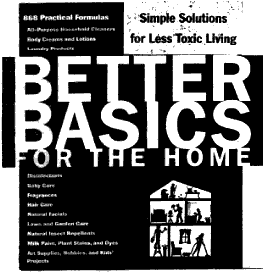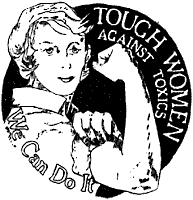
go to WASHINGTON FREE PRESS HOME (subscribe, contacts, archives, latest, etc.)
March/April 2000 issue (#44)
Better Basics for the Home: Simple Solutions for Less Toxic Living
Three Rivers Press, 1999, 339 pages, $18

In 1980 Annie Berthold-Bond worked in a restaurant where she was exposed to a serious gas leak. A month later her apartment was exterminated with a dangerous pesticide.
The "one-two punch" to her central nervous system made her extremely sensitive to chemicals, and she began to search for ways to clean her house, care for skin and body, and do gardening, pet care and pest control without exacerbating her sensitive condition.
The result is the excellent book titled Better Basics for the Home, which includes 868 "practical formulas" for everything from deodorant to natural insect repellent, window cleaners, hair care, and more. Once people start using safe solutions like vinegar, baking soda, club soda, tea, and lemon juice, Berthold-Bond says, they will start "rejecting the vast majority of consumer products."
She says toxic products extend from "hair spray and floor wax to dandelion killers and plastic shower curtains and other products that line our hardware store and supermarket shelves.... Who'd ever have believed that the products we use daily for mundane chores would change the course of life, on both a personal and a planetary scale?"
There are five broad categories of toxins in many everyday products used in the home, the author says. They are pesticides, toxic gases, heavy metals, volatile organic compounds, and plastics. The author explains which products have these harmful additives.
Example of a bad product: "A can of pretty robin's-egg blue paint isn't visibly connected to its ingredients of fungicides and petroleum or to the smokestacks of the factory where it was made." As an alternative, Berthold-Bond gives a recipe for old-time milk paint--which the old New England farmers painted on their famous red barns, and which is nontoxic and functions better than today's toxic synthetic paints, the author says.
Examples of nontoxic products: mint in the garden (which mice avoid), glass cleaner made from distilled vinegar, and deodorant composed of baking soda and corn starch. People use big-name commercial detergents, glass cleaners, floor waxes, dish soaps, shampoos, etc. in the naive belief that industry and/or the government is protecting people. But they will find that this is not the case.
Similarly, the Clean Air Act is not protecting people from air that is causing asthma cases to skyrocket, and the Clean Water Act is not protecting our rivers and lakes from life-killing chemicals.
The napalm splashed over Vietnam, cyanide running through Europe's rivers, and the tons of nuclear waste threatening ecosystems at Washington's Hanford Atomic Energy Reservation are related to the problems that Berthold-Bond addresses. Placing her book in context, she says Better Basics for the Home "is a different kind of survival guide, one in which concern about the environment beyond our home is an urgent priority. If we establish healthy homes, we'll go a long way toward establishing a healthy planet."
Illustration below courtesy of Center for Health, Environment and Justice, www.essential.org.

|
go to WASHINGTON FREE PRESS HOME |